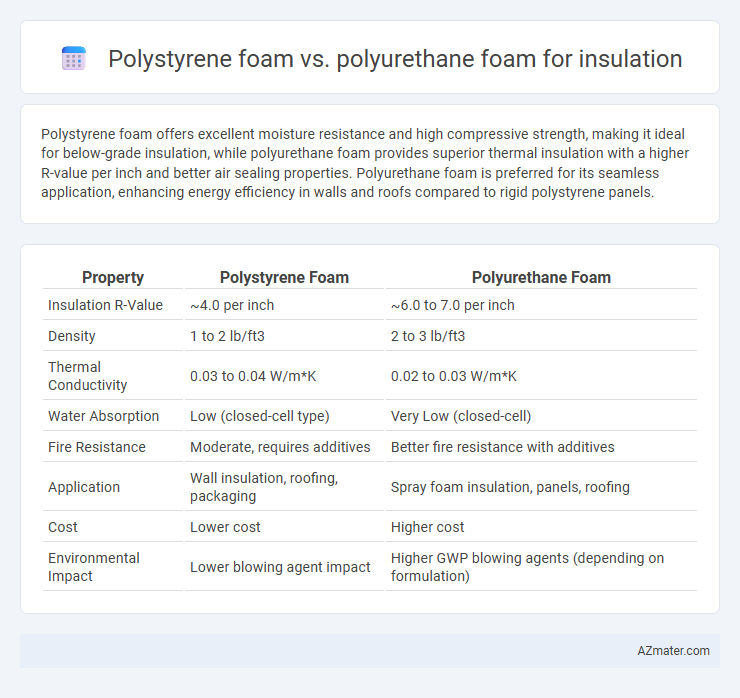Polystyrene foam offers excellent moisture resistance and high compressive strength, making it ideal for below-grade insulation, while polyurethane foam provides superior thermal insulation with a higher R-value per inch and better air sealing properties. Polyurethane foam is preferred for its seamless application, enhancing energy efficiency in walls and roofs compared to rigid polystyrene panels.
Table of Comparison
| Property | Polystyrene Foam | Polyurethane Foam |
|---|---|---|
| Insulation R-Value | ~4.0 per inch | ~6.0 to 7.0 per inch |
| Density | 1 to 2 lb/ft3 | 2 to 3 lb/ft3 |
| Thermal Conductivity | 0.03 to 0.04 W/m*K | 0.02 to 0.03 W/m*K |
| Water Absorption | Low (closed-cell type) | Very Low (closed-cell) |
| Fire Resistance | Moderate, requires additives | Better fire resistance with additives |
| Application | Wall insulation, roofing, packaging | Spray foam insulation, panels, roofing |
| Cost | Lower cost | Higher cost |
| Environmental Impact | Lower blowing agent impact | Higher GWP blowing agents (depending on formulation) |
Introduction: Polystyrene Foam vs Polyurethane Foam
Polystyrene foam and polyurethane foam are two widely used materials for thermal insulation in construction, each offering distinct advantages based on their chemical composition and physical properties. Polystyrene foam, available as expanded (EPS) or extruded (XPS), provides excellent moisture resistance and rigidity, making it ideal for foundations and walls. Polyurethane foam boasts a higher R-value per inch, superior air-sealing capabilities, and versatile applications including spray foam insulation that conforms to irregular surfaces.
Material Composition and Structure
Polystyrene foam consists of rigid, closed-cell beads primarily made from polymerized styrene, offering high compressive strength and moisture resistance ideal for insulation. Polyurethane foam features a flexible, open or closed-cell structure created by reacting polyols with diisocyanates, providing superior thermal resistance and air sealing capabilities. The dense, uniform cell structure of polystyrene contrasts with the versatile cellular makeup of polyurethane, affecting their insulation performance and applications.
Thermal Insulation Performance
Polystyrene foam offers a thermal conductivity typically ranging from 0.030 to 0.040 W/m*K, making it an effective insulator in walls and roofing applications. Polyurethane foam exhibits superior thermal insulation with conductivity values between 0.020 to 0.025 W/m*K, providing higher R-values per inch and better energy efficiency. The closed-cell structure of polyurethane enhances its moisture resistance and thermal performance compared to the more rigid polystyrene foam.
Moisture Resistance and Water Absorption
Polystyrene foam, especially extruded polystyrene (XPS), exhibits superior moisture resistance with low water absorption rates typically below 1.5%, making it highly effective for insulation in damp environments. Polyurethane foam, while offering excellent thermal insulation properties, tends to absorb more water over time, with water absorption rates ranging from 3% to 8%, which can reduce its insulation performance and durability. Choosing polystyrene foam ensures better long-term moisture management and structural integrity in insulation applications exposed to water or high humidity.
Compressive Strength and Durability
Polystyrene foam offers higher compressive strength, typically ranging from 14 to 60 psi, making it suitable for applications requiring resistance to heavy loads and long-term structural stability. Polyurethane foam, while generally lower in compressive strength (around 10 to 30 psi), provides superior durability due to its closed-cell structure, enhanced resistance to moisture, and better thermal insulation properties under varying environmental conditions. Choosing between polystyrene and polyurethane foam depends on specific insulation demands prioritizing mechanical load-bearing capacity versus long-term resilience and moisture resistance.
Fire Resistance and Safety Ratings
Polystyrene foam offers moderate fire resistance but typically emits toxic gases when burned, resulting in lower safety ratings compared to polyurethane foam. Polyurethane foam is often treated with fire retardants, improving its fire resistance and meeting stricter safety standards such as ASTM E84 Class A rating. For insulation purposes, considering fire resistance and compliance with building codes like NFPA 286 is crucial when choosing between polystyrene and polyurethane foam.
Environmental Impact and Sustainability
Polystyrene foam, commonly used in insulation, has a higher environmental impact due to its non-biodegradable nature and reliance on petroleum-based raw materials, leading to long-term waste management challenges. Polyurethane foam offers better thermal insulation performance and can be formulated with bio-based polyols, enhancing its sustainability profile, though it still involves some use of fossil fuels and emits greenhouse gases during production. Efforts to improve polyurethane foam's eco-friendliness focus on recycling and developing renewable feedstocks, positioning it as a more sustainable option compared to polystyrene foam in insulation applications.
Installation Methods and Ease of Application
Polystyrene foam, available in rigid panels, is typically installed using adhesive or mechanical fasteners, offering straightforward handling and easy cutting for precise fits in wall cavities and roofing applications. Polyurethane foam is sprayed onto surfaces where it expands and hardens, providing seamless insulation with superior air sealing but requiring professional equipment and expertise for proper application. Polystyrene's rigid form allows quicker DIY installation, while polyurethane's spray method demands trained applicators to ensure effective coverage and safety.
Cost Comparison and Economic Value
Polystyrene foam typically offers a lower initial cost per board foot compared to polyurethane foam, making it a budget-friendly option for large-scale insulation projects. Polyurethane foam, while more expensive upfront, provides superior R-value per inch, which can result in greater long-term energy savings and improved economic value through reduced heating and cooling expenses. The overall cost-effectiveness depends on project requirements, with polystyrene favored for basic insulation needs and polyurethane preferred for high-performance, energy-efficient applications.
Best Use Cases and Practical Recommendations
Polystyrene foam offers excellent moisture resistance and high compressive strength, making it ideal for below-grade insulation and applications requiring structural support, such as foundation walls and perimeter insulation. Polyurethane foam provides superior thermal resistance with higher R-values per inch, making it the best choice for tight spaces, roof insulation, and areas needing an air-tight seal to prevent heat loss. For practical use, select polystyrene when durability in damp conditions is critical, whereas choose polyurethane foam when maximizing energy efficiency through superior insulation performance is the priority.

Infographic: Polystyrene foam vs Polyurethane foam for Insulation
 azmater.com
azmater.com